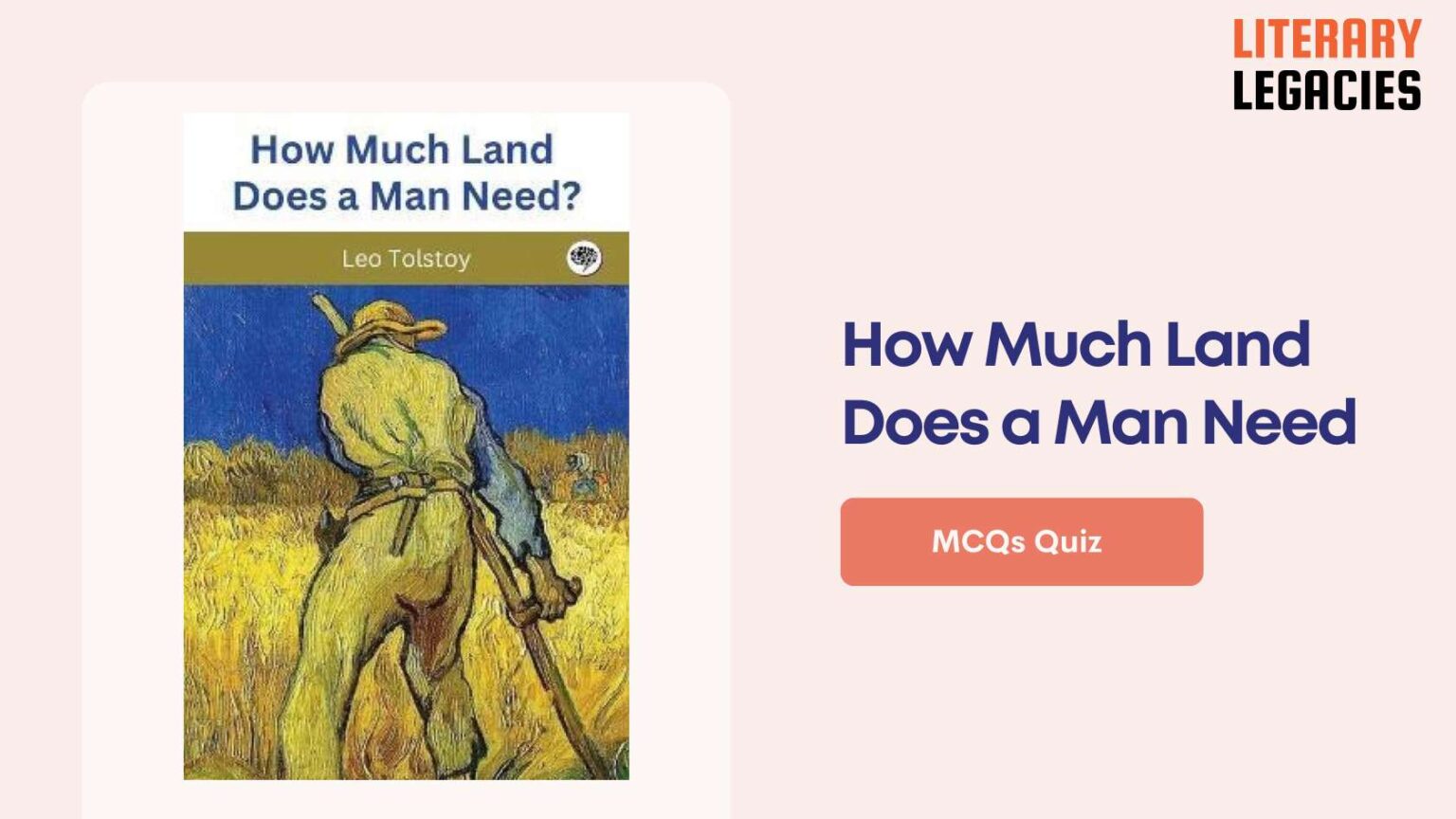1. What is Pahom’s primary goal in the story?
A. To spread the word of the Devil’s power
B. To help his neighbors by sharing his resources
C. To become a respected member of his community
D. To rise to the upper class by purchasing as much land as possible
Answer: To rise to the upper class by purchasing as much land as possible (D)
Pahom’s relentless pursuit of land is driven by his desire to elevate his social status.
2. What is the condition for Pahom to acquire the land offered by the chief of the clan?
A. He must return to the exact point he started from
B. He must pay the full price upfront
C. He must work for the clan for a year
D. He must abandon his current land holdings
Answer: He must return to the exact point he started from (A)
Pahom must encircle the land and return to the starting point to secure the deal.
3. What is the outcome of Pahom’s endeavour to acquire more land?
A. He dies from exhaustion
B. He loses all his money and land
C. He is forced to flee the community
D. He becomes the wealthiest man in the region
Answer: He dies from exhaustion (A)
Pahom’s greed and ambition ultimately lead to his downfall.
4. What is the significance of the six feet of land mentioned in the story?
A. It is the amount of land Pahom needs for his grave
B. It is the amount of land Pahom needs to become wealthy
C. It is the land where Pahom meets the stranger
D. It is the size of the land Pahom is allowed to purchase
Answer: It is the amount of land Pahom needs for his grave (A)
The six feet of land serves as a poignant reminder of the futility of Pahom’s pursuit of wealth and status.
5. What motivates Pahom to investigate the land offered by the stranger?
A. His fear of the Devil’s wrath
B. His greed and desire for more land
C. His sense of obligation to the community
D. His desire to help the clan in need
Answer: His greed and desire for more land (B)
Pahom’s greed and ambition drive him to pursue the opportunity, despite the risks involved.
6. What is the nature of Pahom’s relationship with his neighbours?
A. He is hostile and possessive towards them
B. He is in a romantic relationship with one of them
C. He is indifferent to their presence
D. He is kind and generous towards them
Answer: He is hostile and possessive towards them (A)
Pahom’s focus on accumulating wealth and status leads him to become hostile towards those around him.
7. What is the symbolic significance of the land in the story?
A. It represents the futile pursuit of wealth and status
B. It represents the key to eternal life
C. It represents the power of the Devil
D. It represents the source of all happiness
Answer: It represents the futile pursuit of wealth and status (A)
The land serves as a symbol of the empty and ultimately destructive pursuit of material wealth and social status.
8. What is Pahóm’s primary dissatisfaction with his life?
A. His lack of land
B. His social status
C. His relationship with his neighbors
D. His family life
Answer: His lack of land (A)
Pahóm is initially unhappy with his life because he does not have enough land.
9. How would you describe Pahóm’s behavior when he gets frustrated?
A. He shows a bad temper and takes it out on his family
B. He becomes calm and patient
C. He becomes quiet and withdraws
D. He starts to cry
Answer: He shows a bad temper and takes it out on his family (A)
Pahóm has a bad temper and can lash out at his family when he gets frustrated.
10. What is a characteristic that helps Pahóm in his pursuit of land?
A. His foolishness
B. His shrewdness
C. His naivety
D. His laziness
Answer: His shrewdness (B)
Pahóm is shrewd and ambitious, which helps him in his negotiations and pursuit of land.
11. What is a consequence of Pahóm’s increasing land ownership?
A. He becomes more popular with his neighbors
B. He becomes less ambitious
C. He has fewer quarrels with peasants
D. He has more responsibilities and burdens
Answer: He has more responsibilities and burdens (D)
As Pahóm acquires more land, he also takes on more responsibilities and burdens.
12. How would you describe Pahóm’s attitude towards his possessions?
A. He is indifferent to his possessions
B. He is content with what he has
C. He is never satisfied with what he has
D. He is always grateful for what he has
Answer: He is never satisfied with what he has (C)
Pahóm is never satisfied with what he has and always wants more.
13. What is a characteristic that contributes to Pahóm’s downfall?
A. His generosity
B. His humility
C. His acquisitiveness and greed
D. His kindness
Answer: His acquisitiveness and greed (C)
Pahóm’s desire for more and better things ultimately leads to his downfall due to his acquisitiveness and greed.
14. What can be inferred about Pahóm’s relationship with his wife?
A. He is unhappy in his marriage
B. He is a good husband
C. He is divorced
D. He does not consult his wife about his decisions
Answer: He is a good husband (B)
Pahóm appears to be a good husband, as his wife is content with their life together and he consults her about his ideas.
15. What motivates Pahóm to engage in land acquisition?
A. The need to provide for his family
B. The hope of achieving spiritual enlightenment
C. The fear of lagging behind his neighbors
D. The desire to improve his social standing
Answer: The fear of lagging behind his neighbors (C)
Pahóm’s envy towards his neighbor’s purchase of 50 acres drives him to acquire more land.
16. What is the result of Pahóm’s quest for more land?
A. Improved relationships with his neighbors
B. Increased peace of mind
C. A loss in other areas of his life
D. A sense of contentment
Answer: A loss in other areas of his life (C)
Each gain in land coincides with a loss in some other area of life, such as peace of mind.
17. How does Pahóm’s status in the Commune change after acquiring more land?
A. It remains the same
B. It becomes unclear
C. It worsens significantly
D. It improves significantly
Answer: It worsens significantly (C)
Though Pahóm had more land, his place in the Commune was much worse than before.
18. What is Pahóm’s initial attitude towards land ownership?
A. Understandable and relatable
B. Ambivalent
C. Cautious
D. Skeptical
Answer: Understandable and relatable (A)
His ambition to become a landowner is understandable, and his desire to prosper is relatable.
19. What triggers Pahóm’s envy towards his neighbor?
A. His neighbor’s social status
B. His neighbor’s purchase of 50 acres
C. His neighbor’s wealth
D. His neighbor’s farming techniques
Answer: His neighbor’s purchase of 50 acres (B)
Pahóm feels envious when he hears that one of his neighbors is buying 50 acres of land.
20. What is a consequence of Pahóm’s increasing wealth?
A. Threats to burn his building down
B. Improved relationships with his neighbors
C. A sense of fulfillment
D. Increased respect from the community
Answer: Threats to burn his building down (A)
Quarrels with his neighbors and even threats to burn his building down arise after he purchases more land.
21. What does the sun symbolize in the story?
A. Pahóm’s wealth and status
B. The course of a man’s life, the urgency of Pahóm’s desire, and his ultimate descent into darkness, death, and hell
C. Pahóm’s relationship with his neighbors
D. The land and its significance
Answer: The course of a man’s life, the urgency of Pahóm’s desire, and his ultimate descent into darkness, death, and hell (B)
The sun’s journey throughout the day is used to symbolize the different stages of a man’s life.
22. What is the significance of the color red in the story?
A. It symbolizes life and vitality
B. It has no particular significance
C. It symbolizes the land and its importance
D. It symbolizes death and blood
Answer: It symbolizes death and blood (D)
The color red is ominous and suggests the stirring fire of Pahóm’s desire, which will ultimately lead to his downfall.
23. How does Pahóm feel at noon?
A. Weary and disappointed
B. Confident and energetic
C. Desperate and hopeless
D. Increasingly uncomfortable and determined
Answer: Increasingly uncomfortable and determined (D)
As the sun reaches its peak, Pahóm is feeling increasingly uncomfortable, but he is determined to continue.
24. What does the sun’s descent to the horizon symbolize?
A. The importance of wealth and status
B. The growth of a man’s life and vigor
C. The decline of life and vigor over the course of a man’s life
D. The power of desire and ambition
Answer: The decline of life and vigor over the course of a man’s life (C)
As the sun sets, it symbolizes the decline of life and vigor, marking the beginning of Pahóm’s downward spiral.
25. Why does Pahóm break into a run?
A. Because he wants to get back to his neighbors
B. Because he is desperate and fears he may die
C. Because he wants to show off his strength
D. Because he is feeling confident and energetic
Answer: Because he is desperate and fears he may die (B)
Pahóm’s desperation and fear of death drive him to break into a run, despite the immense physical distress it causes.
26. What does the sun’s heat symbolize?
A. The power of life and vitality
B. The strength of Pahóm’s desire
C. The importance of the land
D. The weakness of Pahóm’s character
Answer: The strength of Pahóm’s desire (B)
The sun’s heat symbolizes the strength of Pahóm’s desire, which drives him to continue his pursuit of land.
27. What is the significance of the morning red in the story?
A. It symbolizes Pahóm’s relationship with his neighbors
B. It symbolizes the stirring fire of Pahóm’s desire
C. It symbolizes the beginning of Pahóm’s life
D. It symbolizes the land and its importance
Answer: It symbolizes the stirring fire of Pahóm’s desire (B)
The morning red symbolizes the stirring fire of Pahóm’s desire, which will ultimately drive him to his downfall.
28. What type of irony occurs in Part 1 of the story?
A. Irony of fate
B. Verbal irony
C. Situational irony
D. Dramatic irony
Answer: Situational irony (C)
Situational irony is a type of irony where events unfold in a way that is contrary to what one might reasonably expect to happen.
29. What is the opposite of what Pahóm says about peasants in the story?
A. They are tempted by the Devil
B. They are not tempted by the Devil
C. They have time to let any nonsense settle in their heads
D. They have no time to let any nonsense settle in their heads
Answer: They have time to let any nonsense settle in their heads (C)
Pahóm says that peasants have no time to let any nonsense settle in their heads, but the irony is that he is the one who succumbs to temptation.
30. What is the result of Pahóm’s actions in accumulating more and more land?
A. He becomes more greedy and wants more
B. He becomes more content with his life
C. He loses everything he has gained
D. He becomes rich and prosperous
Answer: He loses everything he has gained (C)
Despite his efforts to accumulate more land, Pahóm ends up losing everything he has gained due to his greed.
31. What is the irony in Pahóm’s statement about peasants?
A. He is not a country dweller
B. He is the one who is tempted by the Devil
C. He is not a peasant
D. He is not tempted by the Devil
Answer: He is the one who is tempted by the Devil (B)
The irony is that Pahóm, a peasant, says that peasants have no time to let any nonsense settle in their heads, but he is the one who is tempted by the Devil.
32. What is the underlying theme of the story?
A. The significance of social status
B. The importance of hard work and perseverance
C. The dangers of greed and ambition
D. The value of material possessions
Answer: The dangers of greed and ambition (C)
The story highlights the dangers of greed and ambition, as Pahóm’s quest for more land ultimately leads to his downfall.
33. What is the irony in Pahóm’s behavior?
A. He is content with his material possessions
B. He is generous with his wealth
C. He is unhappy with his life
D. He is behaving in what he thinks is the best possible way, but is in fact digging his own grave
Answer: He is behaving in what he thinks is the best possible way, but is in fact digging his own grave (D)
The irony is that Pahóm is behaving in what he thinks is the best possible way, but is in fact digging his own grave through his greed and ambition.
34. What is illustrated concisely when Pahóm’s greed gets him into difficulties marking out his square of Bashkir land?
A. The value of hard work and dedication
B. The irony of Pahóm’s situation
C. The significance of social status
D. The importance of patience and perseverance
Answer: The irony of Pahóm’s situation (B)
The irony of Pahóm’s situation is illustrated concisely when his greed gets him into difficulties marking out his square of Bashkir land.



